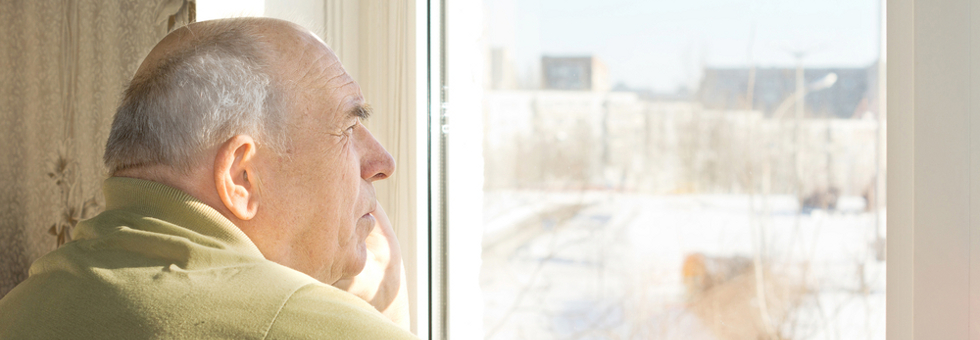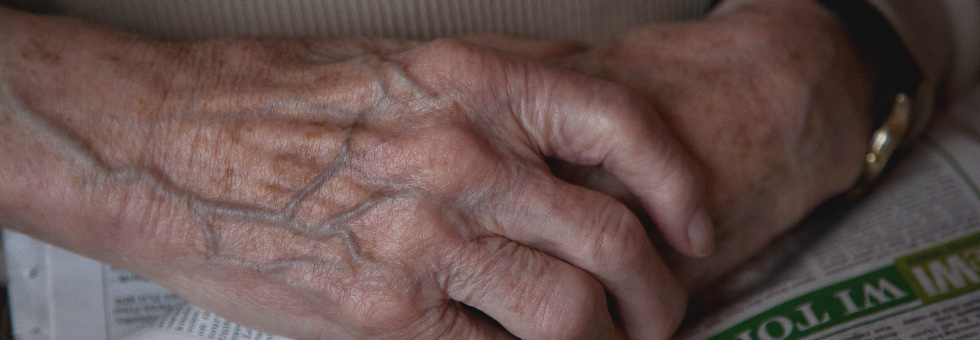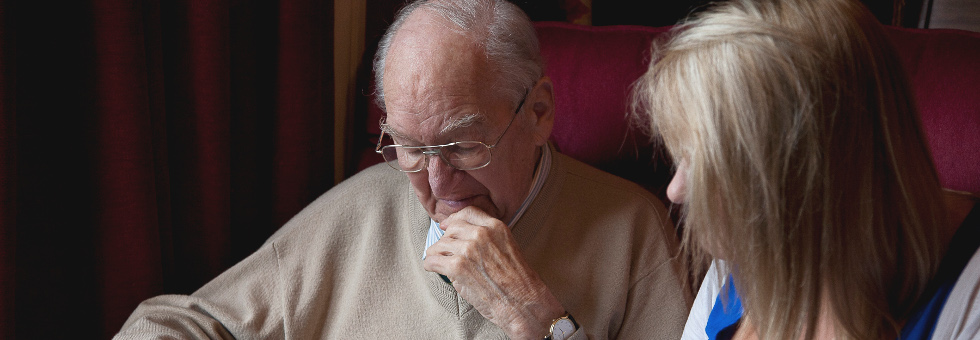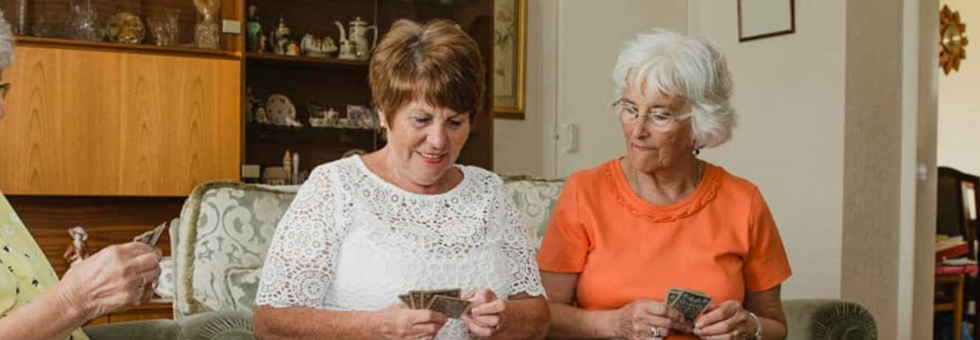Contents
This stage of the case study provides the following information.
- The Personal History sets out what is happening for Don and Madge.
- Values and Ethics – Relating to transitions
- Law and policy – Relating to wellbeing and participation in assessment and care planning
- Knowledge, Evidence and Good Practice – Relating to: Fear of falling; The cumulative impact of long-term conditions on emotional wellbeing; Making difficult decisions; Difficult decisions – where to live
- Skills – Relating to transitions and responding to people’s experience of change
- Activities – Relating to: Supporting and promoting wellbeing; Local Authority response; Self reflection; Approaches to end of life
- Additional resources – Relating to: Housing; Care homes; Further research; Transitions
Personal History
Unfortunately, after a period of relative stability, Don’s health deteriorated and his mobility and ability to participate in his own personal care diminished. He experienced a loss of confidence and his mood started to deteriorate as his feelings of anxiety returned. He fell again in his bedroom while the carers were with him.
Don started to press his emergency call button again during the night and told the operator that he was afraid and lonely. His carers were concerned about Don’s ability to manage longer term and contacted the adult social care team to raise a safeguarding concern in terms of Don’s safety at home and his mental health and well being.
After a reassessment, the social worker, Jodie, arranged additional visits at midday, as Don was feeling anxious about getting to the toilet and being alone during the day. She encouraged Don to consider attending a lunch club in the town or a day centre in a local care home, but he could not contemplate either. The nearby day centre had closed and reliance on voluntary transport was a significant barrier to accessing other resources.
The CPN reviewed Don’s situation with Jodie and they concluded that there were insufficient grounds for suggesting that Don needed an in-patient mental health assessment. The GP and diabetes nurse reviewed Don’s medication and agreed that there was no additional medical treatment that would help. Rather, it was a case of managing the co-existing long term conditions which increasingly impacted on Don’s daily life and well being.
The situation held for a few days until Don again started pressing his alarm during the night as he was afraid of falling when he went out to the toilet. Clearly, Don could not easily remain at home without significant change to his existing care and support. Jodie arranged a meeting with Don and Charlie where there was a difficult conversation about Don’s future and where he should live. The options they considered were:
- Remaining at home
- Moving to a care home
- Moving to housing with care
Values and Ethics
To work with frail older people in a way that promotes their dignity and well-being it is necessary to recognise and value them as individuals shaped throughout their lives by a unique set of relationships and experiences. Equally it is important to be alert to the ways in which progressive or sudden changes in health and other circumstances may impact on the older person and his or her decision making, coping strategies and resilience.
This phase of the case study has been looking at the options that may be available to Don as he decides whether to stay put or to leave the home he shared with his beloved Madge for so many years. An additional factor, which may well be influencing Don’s thinking about what to do next, is that he may not live very much longer. Although there is no way to know when Don will die, it is clear given his age and state of health that he is in, or moving towards, the last phase of his life. We know that Don has already made preparations for his funeral and he may have prepared an Advance Decision and/or an Advance Statement (see Section 3 and Section 5).
Oliver, Foot and Humphreys (2014) confirm that for many older people, unlike a person with terminal cancer, there is no specific moment or event to tie in with discussions about end of life and care/treatment preferences at the end of life. Nevertheless, they advise that it is important to initiate discussion, when it is suspected that someone may be approaching the end of life, as a first step towards assessing their physical, mental, social and spiritual needs. More generally, it is considered good practice in policy and clinical/practice guidelines to enable older people to feel able to discuss and plan for end of life, if that is what they want to do, so that appropriate referrals to relevant health and social care professionals can be made.
The Association of Palliative Care Social Work (APCSW) in partnership with the British Association of Social Work (BASW) (2016) have developed good practice guidance on the role of social workers in palliative, end of life and bereavement care. Building on the EoLC/TCSW (2012) guidance, the document emphasises the important role that non-specialist social workers play in working positively with people as they near end of life.
Click here to explore the APCSW (2016) guidance on social work, palliative, end of life and bereavement care.
References
End of Life Care Programme and The College of Social Work (2012) The route to success in end of life care – achieving quality for social work.
Oliver, D., Foot, C. and Humphries, R. (2014) Making our Health and Social Care Systems Fit for an ageing population, London: Kings Fund.
Law and Policy
The local authority has a continuing duty to promote Don’s wellbeing under the Care Act 2014 (s.1). This ‘principle of wellbeing’, rests on an understanding of wellbeing as a broad concept which will be shaped by individual circumstance and applied regardless of the complexity of a person’s needs (DH 2016: Chapter 1).
See Section 1 of the Case Study for further details of the ‘principle of wellbeing’
Two other key principles from the Statutory Guidance to the Care Act 2014 provide important mandates for this stage of working with Don.
(i) Don’s ‘views, wishes, feelings and beliefs’, must be considered as this is critical to a person-centred system (DH 2016: 1.14b).
It may be that Don’s wellbeing is now so compromised that he decides he can no longer stay in his own home. But supposing Don decides that he wants to remain at home? Although Charlie, the care workers and the GP seem doubtful that any more can be done to support Don at home, their views must carry less weight than Don’s because:
(ii) It is important to begin ‘with the assumption that the individual is best-placed to judge the individual’s wellbeing’ (DH 2016:1.14a).
Don is expressing intense anxiety and emotional distress, but his decision-making capacity is not in question at this moment. The implications for practice are that Don knows best what matters to his wellbeing, even if he needs considerable support to achieve it. It is therefore essential to guard against assumptions that Don’s frailty and the complexity of his needs mean that moving to a care home is the best (and obvious) choice. This means considering whether there are other, creative interventions that might support Don to remain at home and experience an improvement in his current wellbeing.
Further points to consider:
a) Enabling Don to participate as fully as possible in decision making may require, for example, the use of aids and approaches to support his communication. It may also help to use an independent advocate for Don under s.67 of the Care Act 2014, if it seems that his views may not be heard.
See Section 7 of the Case Study for information about communication and stroke.
b) What is the impact on Charlie of trying to support his Uncle from a distance in a situation of rapid change and escalation of need? Is it reasonable, for example, for Don to decide to stay at home and it to be assumed that Charlie will continue to respond when called? A support plan geared towards Don remaining at home should consider what Charlie might reasonably be asked to do to support his Uncle. Similarly, if Don decided to move house, consideration must be given to Charlie’s needs as his roles and responsibility change. Another guiding principle in the Statutory Guidance to the Care Act 2014 concerns ‘the importance of achieving a balance between the individual’s wellbeing and that of any friends or relatives who are involved in caring for the individual (DH, 2016:1.14f).
Research in Practice for Adults also has a dedicated website of resources for Carers.
c) The social worker must be able to link Don and Charlie to relevant, good quality information and advice to help them make decisions about Don’s future care and support needs. In the Care and Support Statutory guidance, ‘information’ in this context is defined as:
‘…the communication of knowledge and facts regarding care and support’
and advice is defined as ‘helping a person to identify choices and/or providing an opinion or recommendation regarding a course of action in relation to care and support’ (DH, 2016: 3.8)
The kinds of information and advice that Jodie might offer Don and Charlie include: locally available housing and housing-related support options; services and resources to support independent living and to reduce social isolation and loneliness; sources of financial and other independent advice. The Knowledge and Skills Statement for Social Workers in Adult Services (DH, 2015) highlights the importance of social workers developing and maintaining knowledge and community partnerships in order to connect people effectively with appropriate resources and support. To achieve this Jodie will also need to consider:
- The type, extent and timing of advice and information. The Statutory Guidance emphasises the importance of tailoring information to individual need and circumstance, to avoid, for example, too much information or the wrong type of information at the wrong time (DH, 2016: 3.32).
- The kinds of information on offer (for example, is it accessible, understandable, relevant?). Statutory Guidance stipulates that information should be available in a variety of formats, not just leaflets and web based material, to take account of factors such as visual impairment, learning difficulties and language (DH, 2016: 3.35).
- Information about where to go for further or more detailed information and advice.
d) Assessment of Don’s needs should be seen as an ongoing and integral part of his care and support system as his needs change. Unplanned reviews of Don’s care have taken place but a further re-assessment of his current needs is indicated, as the additional support visits that Jodie arranged only recently are not meeting Don’s needs. The principles of assessment have been discussed in Section 4 of the Case Study. Any reassessment should:
- Involve Don and his family and acknowledge the centrality of Don’s expertise about his individual experience and needs (DH, 2015 and 2016)
- Incorporate the principle of well being
- Consider a further carer assessment
- Include Don’s strengths and resources as well as his difficulties and challenges
- Include evidence and analysis from the unplanned review
- Incorporate social work knowledge and skills, which demonstrate understanding of the impact of trauma, loss, disability and ill health, ageing and end of life issues (DH, 2015)
- Consider further inter-professional and specialist assessments. Fit for Frailty, a report by the British Geriatrics Society (BGS), highlights the importance of carrying out a multi-faceted, comprehensive review when working with older, frail people, including: social, environmental, psychological, medical and functional factors (BGS, 2014)
Oliver, Foot and Humphries (2014:15) have highlighted that frailty is a ‘key issue for modern health and social care services, yet it has been neglected in many local strategies for long-term conditions’. Their review of evidence highlights the importance of developing coherent policy and practice which prevents avoidable admissions to long-term care. In common with other frail, older people, Don’s story demonstrates how any illness or health change can have significant consequences for the older person, including an increase in falls and failure to thrive. Currently Don is at risk of moving to residential care. Might this be avoided by other kinds of intervention and support, including housing adaptations and assistive technology? An active approach to addressing Don’s falls, their causes and consequences, together with social interventions which address his isolation and emotional needs and take account of his biography, interests and abilities should be considered.
Click here to explore the Kings Fund Report, ‘Making our Health and Social Care Systems Fit for an ageing population’ (Oliver, Foot and Humphries, 2014)
Click here to learn more about the British Geriatrics Society report on older age and frailty
e) If Don’s care and support arrangements change, information should be given about any financial implications such as the costs of additional care at home or of community activities and the cost implications of moving to alternative housing or a care home. Don may need financial advice – not just from Charlie, who has lasting power of attorney, – but also from an independent source to help him make decisions and choices.
Chapters 8 and 9 of the Care and Support Statutory Guidance provide detailed guidance on charging and financial assessment and deferred payments.
Age UK provide Factsheets about paying for care.
References
British Geriatrics Society (BGS) (2014) Fit for Frailty.
Department of Health (DH) (2015) Knowledge and Skills Statement for Social Workers in Adult Services.
Department of Health (DH) (2016) Care and Support Statutory Guidance: to support local authorities implement the Care Act 2014.
Oliver, D., Foot, C. and Humphries, R. (2014) Making our Health and Social Care Systems Fit for an ageing population, Kings Fund.
Knowledge, Evidence and Good Practice
a) Fear of Falling
Don has had another fall and his feelings of intense anxiety have returned. Fear of falling, as well as recent major life events, may be affecting his wellbeing. Don’s falls and their possible implications have not been assessed.
People aged 65 and over are at the highest risk of falling, with an estimated 30% of people 65+ and 50% of people 80+ reported to fall at least once a year (NICE, 2013). Falls are estimated to cost the NHS 2.3 billion per year. For the individual, fear of falling can have a distressing and significant impact on emotional wellbeing with consequences, including heightened worry, anxiety, loss of confidence, and avoidance of activity (Parry et al., 2014). Although collecting reliable data is problematic, Parry et al. (2014) estimate that fear of falling affects up to half of community dwelling older people who do fall/have fallen and up to half of those people who have never fallen.
Currently we do not know what are the most effective strategies to address fear of falling and associated adverse consequences (Parry et al., 2014). There is interest in the relationship between self-efficacy and fear of falling and research has begun to explore the potential benefit of a CBT intervention to reduce the implications of fear of falling. At the time of writing, NICE (2013) is unable to recommend CBT interventions as effective in reducing fear of falling, as there is insufficient empirical evidence to support it.NICE recommend a multifunctional assessment to assess risk of falls and the impact of fear of falling. Such an assessment, which draws together different areas, would doubtless help to gain insight into the causes of Don’s falls (for example, his visual impairment), the possible interaction of challenges in his daily routine and their cumulative impact, and whether there are further interventions or adaptations that may help. Assessment areas include:
- Fall history
- Gait, balance, mobility and muscle weakness
- Older person’s perceived functional ability and their fear of falling
- Visual impairment
- Cognitive impairment
- Urinary continence
- Home hazards
- Cardio-vascular examination
- Medication review
| Causes | Effects |
Illness and long-standing conditions, such as:
Conditions relating to living with long-standing conditions, such as:
Sensory impairment, such as:
Medication, such as:
Cognitive impairment, such as:
Life Style activity, such as:
Other personal factors, such as:
Extrinsic factors
|
Possible physical effects:
Possible psychosocial effects:
|
View the NICE clinical guidelines, Falls in older people: assessing risk and prevention
Although the most appropriate intervention/s to address fear of falling remain uncertain, research is clear about the importance of targeted exercise to sustain and improve strength and balance, especially for those people who have already fallen (Public Health, England, 2015). Whether Don remains at home, or moves to another type of housing, he should be supported and encouraged (with appropriate help) to exercise, within his capabilities, to retain and potentially improve his strength and help to build his confidence.
Read the leaflet and associated resources for Falls Prevention produced by The Chartered Society of Physiotherapists, Saga and Public Health England
b) The cumulative impact of long-term conditions on emotional wellbeing
Recently Don has lost his key emotional and confiding relationship, and experienced reductions in his social networks, personally valued roles and responsibilities. The mechanisms Don had in place to protect against emotional and social isolation (Victor and Sullivan, 2015) have been eroded and may result in worsening physical and psychological health.
Bedroom’s downstairs. He could fall again. It’s eating, warmth, safe, all these things for 24 hours, and there is no 24 hour service available to keep people in their own home. To me, you wonder if the stimulation he needs and his identity I think has to be addressed, because it’s really going round into the same old circle from the first… into the first situation where he was deteriorating after Madge’s death, and the consequential issues that happened. And it’s really starting again around that circle, but this time it’s different because to me his future is more threatened. (Jean)
Arguably Don’s reluctance to join activities such as the luncheon club could reflect his struggle to maintain dignity and personal identity in the context of unrelenting change and uncertainty (Lloyd , 2015). His apparent resistance to socialising may signal his attempts to defend against:
- Worries about failing to cope at a social event (for example, fear of falling in public, worries about getting to the toilet safely and on time, embarrassment about eating in public when visually impaired, talking about his bereavement in a social setting)
- Expectations about social engagement (for example, loss of Madge who may have been the social ‘facilitator’; the impact of sensory impairment on social interaction; not being a man who has enjoyed social events).
- The type of social engagement (for example, feeling patronised by the idea of attending a ‘luncheon club’; worries about being a ‘token man’ in a room of older women).
Overall Don may see a luncheon club as reinforcing his changed health status and the loss of valued roles and identity. Given the effort and anxiety involved – is the possible gain worth the potential personal cost?
Based on a roundup of research, Blood (2010: 4) identifies a number of broad themes about what makes for a ‘better life’ for older people with high support needs:
- Continuity
- Personal identity and self esteem
- Meaningful relationships
- Personalised and respectful support
- Positive living environment
- Autonomy, control and involvement in decision making
- Making a contribution
- Enjoying simple pleasures
- Accessible and reliable information
How Don might define a ‘better life’ in his current circumstances is an important area of reflection and exploration. The focus on independence in contemporary social and health policy and practice could result in ill-conceived ideas about how older people with high support needs might achieve a better life. Lloyd (2015:261) poses the question, ‘when independence is no longer possible, what happens next?’ and argues that a well-developed understanding of older peoples’ experiences of advanced old age and declining health remains an important priority for research and practice.
Personalisation envisages a ‘highly tailored’ approach supporting people to make ‘meaningful choices’. This suggests that a sensitive exploration of Don’s losses, isolation and challenges and their implications for his physical and mental health are crucial. It may, for example, be far more important for Don to feel secure and comforted by the care he receives, than to focus on achieving independence in his personal care. Don may prefer to ‘pace’ himself in order to preserve energy for activities which continue to provide some pleasure or sense of achievement. For example, taking care of Sprocket is likely to be important for Don, so he may choose to expend energy on this task. As Don’s sense of identity and self-efficacy are likely to have been eroded by the challenges he faces, it is important to consider how he can stay involved in decision making to help preserve agency and his sense of self.
Click here to access the Joseph Rowntree Summary Report – A Better Life – what older people with high support needs value (Katz et. al. (2011).
c) Making difficult decisions
Now, because the, sort of, almost brutal change from an environment where you are living semi-independently into somewhere where you’re going to be tied to place among other people … I have never experienced it, but the imagination is that that must be pretty horrendous. That’s a huge step to have to take. (John)
There are differences of opinion about Don’s future. Charlie and Don’s carers feel that the time has come for Don to move into residential care. Charlie believes that Don can no longer cope with the demands of living at home, despite an increase in domiciliary care. The carers believe that Don’s anxiety is having such a negative impact that his quality of life is very poor. Karen is less sure about the inevitability of Don moving to a care home and believes that he could stay at home if his sense of wellbeing and security could be improved. A long-term source of comfort, security and, in the main, happiness, Don is reluctant to give his home up but feels at his wits end and is privately afraid that he can no longer cope there. He too is worried that if he moves, he will be separated from his much-loved dog, Sprocket.
See Section 7 of the Case Study for information about companion animals.
There are potential risks that in concerted efforts to ‘take care’ of Don, his voice will be lost amongst the more powerful voices of health and social work/care practitioners and family members. Bowers et al. (2009:5) have commented that ‘the voices of older people with high support needs are so quiet as to be practically silent or indistinguishable from the other people who speak on their behalf’.
I would want time to be able to reflect on the discussion taking place, and for it to be made crystal clear to me that this was not a final decision-making conversation, that I was not going to be moved elsewhere tomorrow. This may be something that I have to face very soon but I’m not being frog-marched out into somewhere that I don’t know. (Helen)
Read the Joseph Rowntree Foundation report to explore the barriers to the voices of older people with high support needs being properly heard.
Jodie can play a pivotal role in supporting Don in decision making in a way that ensures his feelings, concerns and wishes are properly heard and taken account of. Skilful negotiation, advocacy and working constructively with people and systems who have different views and opinions about what is best for Don is crucial
View the Independent Age fact sheet on Independent Advocacy.
Family Group conferences (FGC) are family led decision making processes where a plan is developed and agreed amongst the family and support network to address a concern or problem. FGC started in children and family services and more recently have been successfully used in adult contexts (for example, long term care planning, safeguarding and end of life care). Families (and friends, if present) are, after a discussion to identify the nature of the problem/concern, left by professional representatives to ‘private family time’ in order to help participants find solutions to specific questions or problems (Hobbs and Alonzi, 2013). Professional representatives may give the family a ‘bottom line’ that they must agree on as part of their developed plan (for example, areas of risk which must be addressed as an aspect of safeguarding).
Visit YouTube to watch a short video about Family Group Conferences
A number of Local Authorities now use Family Group Conferences in adult services. Click here for information about Family Group Conferences in Kent.
Family group conferences highlight the importance of Jodie being able to work effectively with FGC convenors or in a process of negotiation and with a system of people who may have different views, concerns and stresses. In Don’s situation a family group conference convenor, would need to consider and plan for:
- Don’s communication needs (taking account of hearing and vision)
- The impact of Don’s anxiety on his ability to participate
- The timing of the meeting (for example, Don may find it easier to concentrate at particular times of the day)
- The venue for the meeting (accessibility, familiarity, resources available)
- Potential care and support needs during any meeting (availability of support, access to facilities)
- Refreshments
- If Don was assessed as lacking decision making capacity, how the meeting could focus on considering what decisions might be in Don’s best interests and ensuring that Don remains involved in the decision making process.
d) Difficult decisions – where to live
(i) Ageing in place
The policy and practice focus on ageing in place were discussed in Section One. Hillcoat-Nallétamby and Ogg (2014:1775) have argued that there has tended to be a ‘compelling rationale’ in policy and practice for ageing in place, created and reinforced by research which has focused on the:
- Emotional significance of home
- Increased attachment to place in older age
- Power of continuity and long-standing occupancy
In other words ‘ageing in place’ has long been regarded as a ‘good thing’ to support or enhance wellbeing, foster independence and self-efficacy and promote continued engagement with neighbourhoods and communities. This is undoubtedly true for many older people but, for some, the benefit of ageing in place as an inevitably ‘good thing’ is questionable as remaining at home alone can feel like a form of ‘house arrest’ (Phillipson and Ray, 2016). It is recognised that some older people may benefit from living in accessible environments, with care and support and access to wider social resources (Hillcoat-Nallétamby and Ogg, 2014).
It seems that Don is experiencing a number of challenges associated with ageing in place. For example:
- His home has not been adapted to take account of his changing needs
- His personal care has been managed, for example, by washing at the sink and moving his bed to the ground floor
- The limitations of the physical environment may put Don at risk of further falls
- He is isolated at home following the death of his wife and major changes to long-standing activities and interests
It is usually assumed that older people having care at home retain more control because carers are working in the older person’s private and ‘defensible space’. But if care is unreliable, poorly delivered, threatens or infringes personal dignity, or encroaches on Don’s sense of ownership of his home, his defensible space is being compromised or threatened. Research (Callahan and Towers, 2014) has found that some older people living at home felt they had less control of their daily lives when compared to older people living in extra care housing and residential care.
Benefits and challenges associated with ‘ageing in place’
| Benefits | Challenges |
| Maintained and evidence suggests, potentially growing satisfaction with home and environment. | Property rich and income poor can result in difficulties maintaining sub standard property |
| Too stressful to contemplate, better to stay put | Homes have rarely been built to accommodate to a variety of needs and abilities e.g. heating |
| Continuity and the potential to experience important life events, and connect with memories and experiences which are strongly associated with place | The physical environment may be hostile to ageing in place with physical impairments; assistive technology may not fully address the challenges e.g. for people who become wheelchair users. |
| Adjust to changing health and abilities in a familiar space and place | Reduced mobility and care needs may force an older person to be more socially isolated |
| Established and long-standing relationships and social networks | Care services may be fragmented, limited or unaffordable |
| Spatial and physical representation of a life lived and its contribution to personal identity, biographical continuity and mastery. | Local communities may change to reflect the needs and aspirations of other community members |
| Lack of information or availability of other viable housing options, easier to stay put | Concerns about security and safety |
Explore the Equality and Human Rights Commission (2011) report ‘Close to home: An inquiry into older people and human rights in home care’
(ii) Residential care
The success or otherwise of a move is likely to be shaped by how an older person perceives and experiences the move, the losses and gains they encounter and the opportunities they have to actively participate in decision-making. Davis and Nolan (2003) highlighted crucial differences in opportunities to exercise agency, control and choice in moving to a care home, between older people “making” a decision, “reaching” a decision, and “realising the inevitable”.
The Care Quality Commission (2015) comment that despite the challenges facing the social care sector, care homes were overall providing good quality care. The ‘outstanding’ care home services provided a culture of care which:
- Puts the views and wishes of people at the centre of their care
- Supports staff to deliver high quality care
- Has values integral to the organisation and demonstrated in all aspects of the organisation
- Has a commitment to professional development of training
Based on the homes that the CQC rated in this report, smaller care homes tend to provide a higher quality of care than the medium to larger homes, which reflects findings from previous CQC reports of their activities.
Although Charlie has said that he feels his Uncle should now move to a care home, he is likely to have had limited exposure to residential homes and may need to know more about them as a suitable housing option. If Don decided to move to a care home, Charlie is likely to be involved in the practicalities of finding a suitable home and helping Don to move. He may need advice, practical support and information to help him achieve this.
My Home Life summarises best practice messages for supporting older people and family members to manage the transition to a care home. Crucially they highlight the importance of support to manage the emotional impact of the move and of care home staff getting the support they need to do this kind of “emotion work”. Practice should focus on minimising the pressure on older people and their families during the transition and provide:
- Coherent, timely and accessible information and/or signposting to other sources of reliable, specialist advice and information;
- Support for the older people and family members to be involved in decision-making as much as they can or want to be involved. Even if the move to a care home is undertaken in an emergency, opportunities to encourage participation should still be actively looked for, encouraged and supported;
- Encouragement for care homes to develop partnerships with family members;
- Encouragement for older people and family members to take part in decisions about the future;
- Awareness of and emotional sensitivity to the consequences of the move to a care home and encouragement for older people and carers to share their fears and concerns.
Saying that you can’t have too many moves. You know, there’s got to be a stage where that’s the final move. You’ve got to try and make that final move appear as though it isn’t the final move, otherwise you’re going to, sort of, say to people they’re going to be… oh, that’s it. I think I’ve told you before about a story about a care home in Italy where you started off on the top floor and then the management gradually talked you into going a floor lower, but everybody knew that if you actually got to the ground floor, that was it, it was all over. And that’s what you’ve got to try and avoid.
People may at the back of their mind…think about it. I mean we know, the age group that we’re in…we’re not preoccupied with end of life, but we know that, you know that you haven’t got much longer left you know. I’m not planning my holidays for 2040 or anything like that. And I don’t know how we do that. How do we do that?
(Mike)
Visit the ‘My Home Life’ website and read more about best practice in supporting an older person to move to a care home
Click here to see a checklist of possible questions family members may ask about the care provided in care homes. Although this resource was developed by ‘My Home Life’ Wales, it is still a very useful document for families and carers living in England.
In supporting discussions about Don’s future housing, Jodie will, with Don, Charlie and possibly Karen and other carers, need to discuss / weigh up:
- Whether Don is actively thinking about moving home and what motivates that thinking
- Whether the challenges of moving outweigh the benefits that Don still experiences at home and are acceptable in light of his current support needs
- The extent to which the challenges for Don’s life at home could be addressed by creative interventions
- The impact that Madge’s death has had on Don’s continued emotional attachment to his home
- The availability of viable alternative housing
- Relationships that are important to Don and how they can be sustained
- Thoughts about future care needs and end of life.
(iii) Extra care housing
Housing with care is an overarching term for ‘ergonomically designed and independent housing units that usually feature common spaces, facilities and care services (Kneale and Smith, 2013, 278). Characteristics that distinguish it from other models of care, such as residential care, include:
- Self contained accommodation with its own front door
- Ethos of supporting independence
- Flexible, on site care over 24 hours
- Availability of collective and social activities
- Communal facilities (e.g. restaurant, café, shop)
(Evans et al., 2014:2).
There has been a growing interest in housing with care as an option for older people who would traditionally have entered residential care (Bäumker et al., 2012). Local authorities have been interested in housing with care schemes as a means of widening the choice of housing options for people who use services. However research suggests that overall, people who move into housing with care tend to be younger, less physically and cognitively impaired than those people moving into care homes and are more likely to move as a proactive decision, rather than moving when remaining at home is no longer an option (e.g. Evans et al., 2014). This raises a question as to the extent to which this can be seen as a replacement option for residential care. Alternatively, extra care housing that focuses on people needing more extensive care and support, results in a community that are all older people with high support needs. This may have a considerable impact on the way a community of this kind can operate (if for example, it relied on tenants to initiate and support social activities or if community volunteering was part of the life of the facility).
Research suggests that a move to housing with care can result in a better quality of life when compared to ‘staying put’ in inadequate mainstream housing. In research which assessed quality of life of residents in housing with care, participants scored a very high quality of life score – better quality of life effectively reduces need for services (Evans et al., 2014: 3). Moreover, low exit figures of residents moving from housing with care to residential care, indicate that housing with care can, for most residents, be considered a home for life (Kneale and Smith, 2013).
Visit the housing research and resources website and a summary of research examining the impact of housing with care on the lives of older people.
In conclusion, although Don may be struggling at home and feel isolated and lonely, moving house is a big step and he and Charlie would need to think about the possible benefits of a move – and the kind of move he might make:
- Whether a move would enhance Don’s quality of life and help him to feel less anxious
- Changes in the amount of personal living space and increase in community/shared space
- Whether Sprocket could move with Don
- The location of other housing options in relation to Don’s current home and community including Karen
- Whether he should consider moving near Charlie and his family
- The care and support cultures offered in other types of housing
- Size, environmental design
- Access to facilities that are important for Don (for example, time outdoors, his GP)
- The availability of good quality advice and information about housing options
- The cost involved in moving and what would happen to Don’s home if he decided to move
- The likelihood of achieving a ‘home for life’ by moving.
References
Bäumker, T., Callaghan, L., Darton, R., Holder, J., Netten, A. and Towers, A. (2012). Deciding to move into extra care housing: residents’ views. Ageing and Society, 32 (7):1215-45.
Blood, I. (2010) Older People with high support needs: A round up of the evidence, York, Joseph Rowntree Foundation.
Bowers, H. (2009) Older People’s vision for long term care, York, Joseph Rowntree Foundation.
Callahan, L. and Towers, A.M. (2014). Feeling in control: comparing older people’s experiences in different care settings. Ageing and Society, 34: 1427-1451 :10.1017/S0144686X13000184
Care Quality Commision (2015) Annual Report.
Davis, S. and Nolan, M. (2003) Making the best of things: relatives experiences of decisions about care home entry, Ageing and Society, 23 (4), pp. 429-450.
Equality and Human Rights Commission (2011) Close to home: An inquiry into older people and human rights in home care.
Evans, S. (2014) Adult Social Care Environments and Settings (ASSET): Research Findings, NIHR, Social Care Research.
Hillcoat-Nallétamby, S. and Ogg, J. (2014). Moving beyond ‘ageing in place’: older people’s dislikes about their home and neighbourhood environments as a motive for wishing to move. Ageing and Society, 34:1771-1796 :10.1017/S0144686X13000482
Hobbs, A. Alonzi, A. (2013),”Mediation and family group conferences in adult safeguarding“, The Journal of Adult Protection, 15(2):69-84
Katz, J., Holland, C., Peace, S., & Taylor, E. with Blood, I. (2011) A Better Life — What Older People with High Support Needs Value, York: Joseph Rowntree Foundation.
Kneale, D. & Smith, L. (2013) Extra Care Housing in the UK: Can it be a Home for Life?, Journal of Housing For the Elderly, 27(3):276-298, DOI: 10.1080/02763893.2013.813423
Lloyd, L., Tanner, D., Milne, A., Ray, M., Richards, S., Sullivan, M.P., Beech, C. and Phillips, J. (2014) ‘Look after yourself: active ageing, individual responsibility and the decline of social work with older people in the UK’, European Journal of Social Work, 17(3): 322-335
Lloyd, L. (2015) The Fourth Age. in J. Twigg and W. Martin (eds) The Handbook of Cultural Gerontology, Abingdon, Routledge, pp.261-268.
Parry, S.W., Deary, V., Finch, T., Bamford, C., Sabin, N., McMeekin, P., O’Brien, J., Caldwell, A., Steen, N., Whitney, S.L., MacDonald, C. and McColl, E. (2014) The STRIDE (Strategies to increase confidence, InDependence and Energy) study: cognitive behavioural therapy-based intervention to reduce fear of falling in older fallers living in the community – study protocol for a randomised control trial, Trials, 15:210.
Public Heath England (2015) Public Health Matters, Blog. Falls: A new Guide on awareness and prevention.
National Institute for Health and Care Excellence (NICE) (2013) Falls in older people: assessing risk and prevention, CG161.
Victor, C. and Sullivan, M.P. (2015) Loneliness and Isolation. J. Twigg and W. Martin (eds) The Handbook of Cultural Gerontology, London, Routledge.
Skills
Don’s story highlights the importance of sensitive and skilful communication and an approach to practice that helps him express his concerns and wishes in the context of considerable uncertainty. Further disruption and change has left him anxious and unsure about his ability to manage now and in the future. It is important for social workers to be sensitive to the feelings of fear, anxiety, sadness and regret that individual older people with high support needs often experience as they cope with physical (and potentially, cognitive) changes which sharply compromise the roles and routines that they have long taken for granted.
Working supportively and constructively to find ways to reduce stress and anxiety is a fundamental skill in social work (Howe, 2014). Don’s ability to engage with the interventions and approaches suggested by Jodie is likely to increase if he believes that she is concerned about him as an individual. An approach is needed which demonstrates understanding and acceptance of his feelings and helps Don to feel safe and to contain his sense that he is losing control (Howe, 2014). In addition Don needs to believe that his social worker is able to give him relevant and accurate advice and information.
The implications for advanced social work skills are significant, not least because of organisational pressures which can compel social workers to feel they must rush practice. The process of achieving a workable plan for Don and his family cannot be concluded immediately so the social worker may experience frustration and stress. In a sense, social workers must face both ways (Brechin, 2000) as they cannot ignore the demands of their organisation but nor too, should they ignore or side line their knowledge, skills, values and professional judgement. Barnes (2012:68) reflects that an emphasis on activity and busy-ness, at the expense of attention to core practice values, can dull practitioners’ sensitivity to poor practice in which corners are cut, decisions are rushed and the integrity of the older person and their right to participate in their own lives is overlooked. Person-centred practice will demand social work skills that empathically support and enable Don to express his concerns in what Tanner (2009) has defined as ‘self talk’ – Don’s feelings, concerns and aspirations, rather than focusing solely on ‘needs talk’ – on resources, abilities and disabilities.
Relationships are at the heart of social work and the relationship between the social worker and Don, Charlie and Don’s wider support system continues to be crucial in this phase. Relationship based practice is characterised by:
- Remembering and approaching each social work encounter as unique Don is not just another older person with complex needs, faced with making a tough decision
- Human behaviour is complex and influenced by multiple factors
We have considered, for example, why Don may be reluctant to consider some types of intervention and what his behaviour may be communicating about his feelings and worries
- Thinking about emotions, social contexts and biological factors in an integrated way
Don’s co-existing long-term conditions and his experience of them are likely to be influenced by other factors, such as his recent loss and reduced self-efficacy, his gender and the views of other people
- Emphasis on the use of self and the relationship through which interventions are directed
Don faces significant difficulties and decisions; he is unlikely to feel safe to face those decisions if Jodie makes him feel that he is a nuisance or a problem
- The use of self implies the social worker being self aware
What are Jodie’s perceptions, fears and assumptions about growing old? How does she feel and think about her ‘ageing self’? How does Jodie’s social work practice fit with/affect, for example, personal experiences of care and ageing? (See, for example, Ruch, 2010; Richards et al., 2007).
The knowledge and good practice section highlighted potential systems based approaches to family decision-making (e.g. family group conference). As Don faces the possibility of moving from his home, it is crucial for Jodie to skilfully negotiate with and between Don, his family and a range of health and social care professionals. This is especially important as there are different opinions about what course of action is ‘best’ for Don. As we have already seen, older people with high support needs may find it almost impossible to express their preferences in the midst of more powerful, professional/family voices.
Realistically, the social worker is likely to be involved in conversations about the potential risks that Don faces by remaining at home, and the daily challenges he is experiencing. Existing risks and challenges may be relatively easy to identify in comparison to helping Don and his family work out the potential risks and benefits of moving. This discussion should involve giving concrete and tailored information about potential housing options. It is not acceptable, for example, to signpost Don and Charlie to a website about local care homes and expect them to ‘get on with it’. This means that the social worker should be knowledgeable and well informed about local housing resources, and be able to help Don and Charlie find out more about them (DH, 2015). Similarly, Don and Charlie may want information about the financial implications of moving and what will happen to Don’s house (See Button 1, Law and Policy). Working with the whole system, means that social workers must continue to use skills to negotiate, mediate and agree potential plans or interventions and to enable Don to voice his views throughout
References
Barnes, M. (2012) Care In Everyday Life: An Ethic Of Care In Practice, Bristol, Policy Press.
Brechin, A., (2000) The challenge of caring relationships. in A. Brechin and M. Eby (eds.) Critical Practice in Health and Social Care, Buckinghamshire, Open University Press, pp.141–163.
Department of Health (2015) Knowledge and skills statements for adults, London, DH.
Howe, D., (2014) The Compleat Social Worker, Basingstoke, Palgrave MacMillan.
Richards, S., Donovan, S., Victor, C and Ross, F (2007) Standing Secure Amidst a Falling World? Practitioner Understandings of Old Age in Responses to a Case Vignette, Journal of Inter-professional Care 21(3):335-349
Ruch, G. (2010) Relationship Based Social Work, London, Jessica Kingsley.
Tanner, D., (2009) Managing The Ageing Experience: learning from older people, Bristol, Policy Press.
Activities
Supporting and promoting wellbeing
Supporting and promoting wellbeing is an underpinning principle of the Care Act 2014. How might you support and promote Don’s wellbeing in light of the challenges and difficulties he is currently experiencing?
Local authority response
How have your local authority responded to the need to provide comprehensive, relevant and accessible information, as defined by the Care Act 2014?
To what extent does the information available support you in your role to provide Don and Charlie with relevant information about specific care and housing options?
How do you make your local authority aware of feedback from older people using the information, or gaps in the information provided?
Self reflection
Reflect on your own feelings, thoughts and assumptions about growing old. What do you look forward to? What might you worry about?
How might your own thoughts and feelings about ageing and growing old impact on your practice with older people?.
Approaches to end of life
How might you approach opening up a conversation about choices at end of life with an older person?
Think about a time in practice when you might have had the opportunity to talk about this, but for whatever reason, did not. What was behind your decision not to talk about this topic?
If the reason related to your own confidence or fears, how might you begin to develop your ability to approach the topic of end of life /dying when it is relevant to do so?
Additional Resources
Additional resources added in 2019:
- Experiences of major life changes in later life.
- Access to cars for older people.
- Housing interventions to support wellbeing in later life.
- Good practice in adaptations to homes.
- Approaches to successful ageing in communities.












